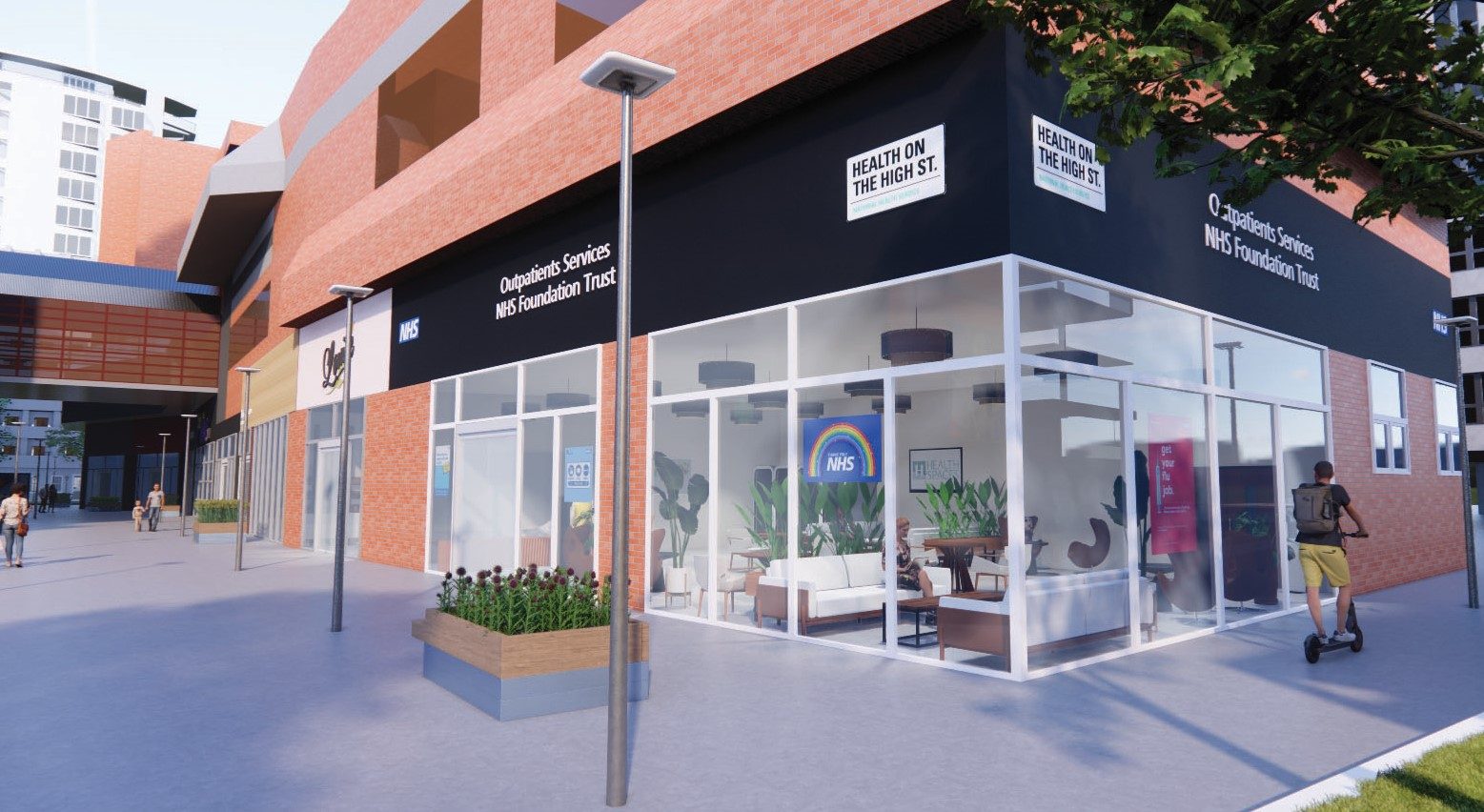The Past/Present and Future of CDCs
CDC insiders Michael Wood, Jonathan Gardner and Nicola Theron reflect on their experiences of delivering NHS services differently
Community Diagnostic Centres (CDCs) are a growing success story – even with the many challenges facing the NHS in its 75th year.
The concept for CDCs was first mooted by the NHS’s cancer tsar, Professor Sir Mike Richards, in his review of NHS diagnostics capacity of October 2020. And in that time, we’ve witnessed shifting attitudes to healthcare and how it is delivered.
“Looking back the pandemic was a key moment when people’s minds were changed, says Michael Wood is Head of Health Economic Partnerships at the Health Foundation. “I had my first vaccine jab at the racecourse and the second one in a shopping centre; citizens realised they don’t need to go to a typical clinical site to receive healthcare, and people really grabbed hold of that. They began to ask, what other services can we move to the high street?
“Can we offer quicker testing, can we change a unit to offer scanning and blood testing without some of the restrictions you need for traditional healthcare settings? Covid showed local leaders they can experiment with different ways of trying to deal with the pressures they are facing,” he says.
Health leaders also recognised that the CDCs were a useful way to reach underserved communities who may struggle to travel to a hospital or be put off by a more formal healthcare setting.
Says Michael Wood: “It’s not just about what services the NHS needs to provide, but where we should provide them. Different populations have different needs, there are communities we struggle to reach, we may not know about them and inequalities may be widening, this is a key part of narrowing those inequalities.”
The CDCs now
CDCs have been opening at pace since 2021 and in June this year, the government announced that 108 CDCs are in operation and had already delivered over four million additional checks for a range of conditions from cancer to heart or lung disease. A further eight new CDCs are due to open soon.
Some of the centres are in football or rugby grounds, some are in leisure centres, some are in shopping centres, and some are attached to hospitals but with separate entrances and exits so they can operate independently.
“It’s about partnering with councils and local communities to understand the best location for the CDC,” says Michael Wood. “I visited the one in Wood Green shopping centre in North London recently [see case study]. It was an old Phones for U shop and it opened last autumn performing blood tests, eye tests and x-rays. Now they’re developing the room downstairs for an MRI scanner. I walked past recently and just did a double-take. It was bustling and just felt so un NHS-like, and that is something to celebrate I think.”
Shopping for health
Situating the CDC in a shopping centre like the Wood Green CDC is not only convenient for local people but also an advantage for the centre itself. “Instead of a nervous six week to go to a hospital, patients can be immediately referred by their GP to a centre in their community and that’s an advantage for high streets as research has found more than 50 per cent stayed in the shopping centre after their test and did some shopping.
“It provides extra capacity for the health service, reduces waiting time, and provides significant footfall through the high street or shopping centre. It’s a win, win,” says Michael Wood.
Engaging with the local community is also an important factor in deciding where the centre should be, and what services they might need. “For example, if a community has a high propensity for diabetes we might need slightly different services there, and that is all part of the journey,” explains Michael Wood.
Three models for CDCs
That said, the CDCs must conform to one of three archetype models. A standard model which offers a minimum of tests and scans including CT, MRI, X-Ray, blood tests, respiratory and cardiology. A large CDC can also offer endoscopy and any other diagnostic testing that is required in the local community as well as scalability – like multiple scanners to improve efficiency.
The final archetype is for a Hub and Spoke model where the hub includes all minimum testing and then a series of ‘spokes’ which provide further capacity for tests with satellite locations, mobile units or pop-ups. These can be useful for large geographical areas.
Despite the drive to situate CDCs in the local communities, in some areas the best place can still be the local hospital. The Finchley Memorial Hospital CDC opened in north London in August 2021 and now offers patients two MRI scanners along with two obstetric ultrasound machines. In addition to this, the hospital is serving the local community with a direct bus route to the CDC as well as pre-bookable, free parking on site. And crucially the CDC must have a separate entrance and exit to the hospital so that it’s not impacting the acute site. In August 2022, just one year after its arrival the trust announced that they had reached 50,000 patients, making a real impact on the local community. Jonathan Gardner, who leads on delivery of CDC’s in north London, told the Times Series: “Every one of these appointments has supported our hospitals to recover from the impact of the pandemic and improved access to diagnostic tests for our patients.”
Michael Wood believes the CDC has a vital part to play in the current workforce shortages facing the NHS. “Being in town centres also allows us to be more visible, and that can help us recruit. We can say to people, ‘Hey we have 350 different careers in the NHS, come and join us.”
He hopes that the opening of the CDCs will prompt some long-term strategic thinking about local communities and NHS estates. “Lots of hospitals and NHS buildings are very old, with a backlog of repairs worth 12 billion. This along with the workforce struggle are two of our biggest challenges. Unlocking new NHS estate and going into local communities gives us a potent business case for future long-term change.”
Case Study – Wood Green CDC
The Wood Green CDC, part of the North Central London ICS, opened in August 2022, providing x-rays, blood tests, ultrasound and eye test services and will soon offer MRI and CT scanning.
Since opening it’s performed over 50,000 tests and won a Health Service Journal award for best consultancy partnership with Capital & Regional, who own The Mall Shopping Centre where the centre is based in a former mobile phone shop.
Nicola Theron, Director of Estates for North Central London, explained how the location was chosen: “Haringey doesn’t have a general hospital, its demographic don’t easily access hospital services and it is an area of need. Situating the CDC in a shopping mall made it easier for that population to access routine diagnostics, without them having to come into a hospital.”
The Trust also had a live relationship with the landlord. “We knew the site was vacant as we’d been talking to Capital Regional about Covid vaccination centres, so we picked up that discussion into a longer-term solution,” says Theron.
Once the site was chosen, focus groups were conducted with the local communities by the Whittington Health NHS Trust engagement team to understand what they were looking for. “These conversations did influence some of the key decisions around graphics and visuals. We also learnt that they wanted the local services to be NHS and not subcontracted to the private sector and for there to be transport access for the disabled,” says Andrea Craig, Project Director for the Wood Green CDC.
There were a number of challenges that had to be overcome before the CDC could officially open, however.
The rent for the premises was higher than the NHS might usually expect to pay. “We are in a retail space in a prominent space, so we have had to pay higher commercial rent than we might hope for. We could have gone into the basement or second floor, but then we lose visibility and people don’t know you’re there. However, in phase two we’ve aggregated our premises with basement space where we have a very competitive rent,” says Nicola Theron.
There were also the technical challenges of using non-healthcare settings for providing healthcare. The CDC had to have very high mechanical ventilation standards so a new system had to be installed. And for phase two water was discovered in the basement so the site had to be drained and made completely watertight to be a suitable home for CT and MRI scanners. “The mall is 40 years old, it’s not like a hospital site where you know what you’re doing. It’s in effect a start-up where you’re ramping up services very quickly. The negotiation was more complicated and we had to put a big contingency in place,” says Theron.
The team were also caught unaware by the need for care quality commission registration. “We made the assumption that because we were linked to Whittington Health Trust their CQC registration would be extended to the Wood Green CDC, but as it’s completely new and in a shopping centre it needs its own CQC registration. This takes a lot of time and engagement and we couldn’t open without that certificate, “ explains Nicola Theron.
Another challenge was the number of stakeholders involved in the project. “You’ve got NHS England behind the scenes, the two local hospitals the Whittington and the Royal Free, the owners of the shopping mall, the design team, our advisers, imagine the complexities of getting everyone to work together, “ says the project director, Andrea Craig.
Yet the myriad of challenges were overcome and now the site is up and running and feels friendly and busy and is seeing a high turnover of patients in a compact space.
Staff are enjoying working there too. “Initially it was hard to get it going as it was a new model, and staff weren’t sure they wanted to work in a shopping centre but once we reached a tipping point with a certain number of people on board, it got easier. Staff like the flexible working hours and the fact they’re not working nights or on call,” says Theron.
Like many centres around the country the Wood Green CDC is delivering on its promise, and hopefully offering a blueprint for the future.
Jonathan Gardner, Director of Strategy, Development and Corporate affairs at Whittington Health Trust, said when the centre won the Health Service Journal award: “I am proud that we are delivering NHS services differently. By bringing diagnostic tests into the heart of Haringey, we are reaching an underserved population and tackling the health inequalities that residents face,” and he told Fortis, that Whittington CDC is now seeing 72% of its referrals from the 30% most deprived deciles of the population.
© Dialogue Content Marketing Ltd 2025.
This article was taken from the September 2023 edition of FORTIS magazine.
FORTIS magazine is a Health Spaces Limited publication. Opinions expressed in FORTIS magazine are not necessarily those of Health Spaces Limited or Dialogue Content Marketing Ltd. Material contained in this publication may not be reproduced, in whole or in part, without prior permission of the publishers. No responsibility can be taken on behalf of advertisements printed in the magazine.
FORTIS magazine – read more
This article was written for the September 2023 edition of FORTIS magazine; a forum for the NHS to share ideas, innovations and case studies. To read the publication in full and access digital copies, visit FORTIS magazine. FORTIS magazine is free for NHS change-makers and leaders and is available as a print or digital copy. FORTIS magazine is managed and owned by Health Spaces Ltd.



